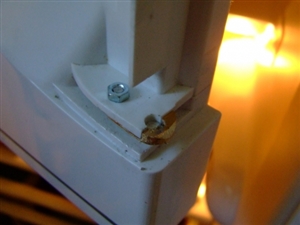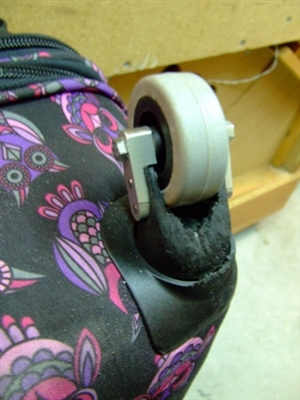To start thing off I have attached a couple of pictures of recent repairs I have made. Did it make sense to make these repairs? I think so.


Best regards
Roger
Andy Millar:
At the other extreme, many years ago I used to have a friend who would "mend" incandescant light bulbs - by twirling them them around with a particular wrist flick action which would cause the free end of the coil to wrap itself around the end it had broken off.
. . .
I once "repaired" a tungsten light bulb like this. It had failed prematurely, having being dropped, which broke the filament. I manipulated it to join the broken ends and it lasted for quite a while.
I found this did not work with bulbs that had run their normal life. I could sometimes rejoin the filament ends and get them to work again but they would last only a short time so not really worth it. And of course sometimes when the lamp "blows", the filament disintegrates so there are no free ends that can be joined.
COULD I DO SOMETHING LIKE THIS NOWADAYS?
Not really. There are very few filament bulbs remaining in our household - all in places where they are seldom used, e.g. the loft. It would not be worthwhile to try to repair them, considering their low luminous efficiency. As for compact source fluorescent lamps and LED lamps, I doubt whether I could use gravity to repair these. It is not as though they are as expensive as they used to be.
Lynne Collis:
Even cars are becoming more difficult to repair, apart from inserting new "black boxes". I could strip a Layland engine down to its con rods, but recently, our garage had to close its repair shop for two weeks while it waited for a new diagnostic computer.
If a headlight fails now, I can't just replace the bulb, it's a complete sealed unit that's required. I'm sure that's more profitable for Peugeot-Citroen, but it creates a lot of waste.
I used to tinker a bit with my early cars - change oil, change filters, change clutch cables even. One car had continuing problems with the carburettor. I lost count of how many times I had it to bits. One day in the early seventies I had the unpleasant experience, whilst driving through central London, of the engine cutting out and refusing to tick-over, though it would run as long as the accelerator was depressed. I managed to find a place to park somewhere I shouldn't and carried out roadside repairs. I dismantled the carburettor and blew the idler jet clear. Reassembled and all OK again.
COULD I DO SOMETHING LIKE THIS NOWADAYS?
No way! As Lynne says, it's all "black boxes" nowadays. Fuel management systems and such like. They are very clever, I agree. Does anyone remember choke controls, cold engine problems, "flat spots"? Consigned to the dim past. It is even possible to climb a 1 in 12 gradient just on the tickover (yes, I tried it once). Failures are rare but if they do go wrong it can be very wrong. I would call the RAC and leave it to the experts with the tools and the know-how.
Oliver Stephen Hannaford-Day:
Thats a NiCad battery. PCB mounted batteries have a tendancy to do that if left alone for 15 years sadly.
The battery acid eats the tracks around the battery and worse, the copper out of the via's. The crystal case was destroyed too.
The crystal has now been replaced and any open circuit tracks have been remade but I think theres damage under some of the chips so will need to desolder the chips (and probably socket them) to check.
Fun times. :-)
I had a television set which one day lost all its channel tuning information. I was able to restore the information but it lost it all again the next time it was switched off. I had a look in the back and found indeed a similar NiCad cell looking in a sorry state, though there was 1·2 V across it with the set switched on. Fortunately the tracks were still in reasonable condition. I could not source an identical cell for replacement, so I just procured what I could - the wrong size so I hitched it to the board with flexible wires. It looked a mess but at least the set retained its tuning again. It lasted several more years, then one day the picture disappeared and it emitted lots of smoke. I decided it was time to send it to WEEE recycling.
COULD I DO SOMETHING LIKE THIS NOWADAYS?
It is getting more difficult. For instance I still have a video tape recorder, used on odd occasions, sometimes for copying video cassette to DVD. It retains the tuning channels OK but if it looses mains power the internal clock stops. Without a service manual I have been unable to identify a cell that would maintain the internal clock under loss of power. I once replaced a similar cell on a laptop computer a few years ago when I was still working. These cells are very small and difficult to distinguish from other components.
Deborah-Claire McKenzie:
For those occasions when you just can't repair things yourself, here's an excellent spares website that I'd recommend as its kept quite a few of our household appliances and other items going for several years www.buyspares.co.uk
This is a good web site and I have used it myself on occasions. The trouble is that spares become less available over time and even sites like this cannot help. I have a Philips Philishave shaver, approaching 60 years old. The shaver still works and does not do a bad job of shaving. The problem is the mains lead - the conductors have fractured inside the insulation so power to the shaver is a bit intermittent and one needs to manipulate the lead carefully. The connector bit that plugs into the shaver is of a type one does not see any more. Philips has standardised on the type of connector that is widely used for small appliances like this. I am unable to get hold of this old type anywhere.
We're about to take you to the IET registration website. Don't worry though, you'll be sent straight back to the community after completing the registration.
Continue to the IET registration site